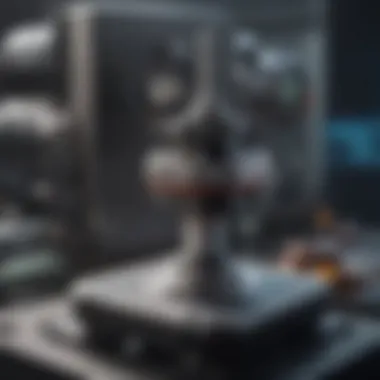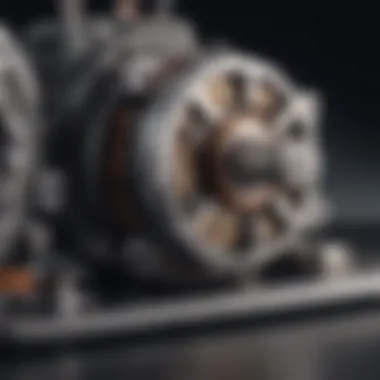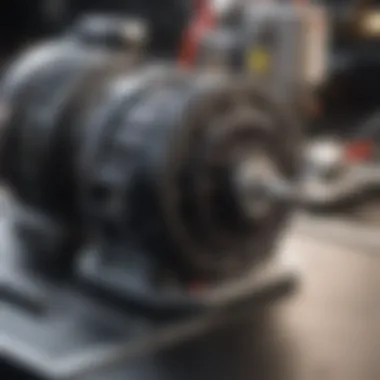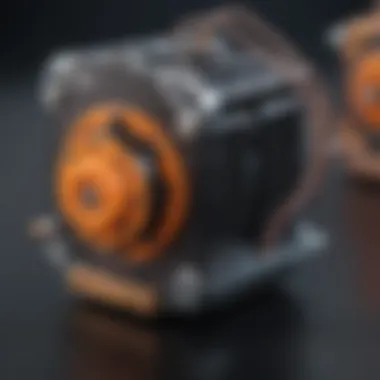Understanding Stepper Motor Position Sensors and Their Impact


Intro
Stepper motor position sensors play a pivotal role in the realm of precision control, making them indispensable tools in various industries—from robotics to manufacturing. They help in determining the exact position of a motor shaft, ensuring accurate movement in countless applications. Understanding how these sensors work, the different types available, and their latest advancements can open new avenues for innovation and efficiency.
The mechanisms behind these sensors are not just about raw functionality; they also reflect the elegant interplay of physics and engineering. Often buried in jargon and technicalities, the finer details paint a picture of how motion can be controlled with astonishing precision.
As the demand for automation continues to climb, the significance of these position sensors has only heightened. Knowing their applications can help practitioners identify where to leverage this technology effectively.
In the sections that follow, we'll explore the intricate mechanisms that define stepper motor position sensors, assess their applications in the field, and discuss the innovations that are shaping their future. This exploration is not merely an academic exercise; it equips students, researchers, and professionals with tools to innovate and improve existing systems.
An Overview of Stepper Motors
In today's fast-paced world of automation and precision engineering, understanding the fundamentals of stepper motors is crucial. These devices serve as the driving force behind numerous applications ranging from 3D printers to industrial robots. Grasping the mechanisms and types of stepper motors provides context for their integration with position sensors, which enhance their operational efficiency. Their distinct functionality and applications not only contribute to their popularity but also to the ongoing innovations in the field of motion control.
Definition and Functionality
Stepper motors are unique types of electric motors that move in precise increments or "steps." This characteristic allows for accurate positioning without the need for complex feedback systems. When powered by a controller, the motor advances in a sequence of defined angles, making it ideal for applications where exact positioning is necessary. Unlike traditional DC motors, which rotate continuously, stepper motors turn a specific angle with each pulse of electricity, which translates to high precision in motion control.
The primary advantage of using stepper motors lies in their ability to achieve repeatable accuracy. This is particularly beneficial in environments that require high precision, such as CNC machining and robotics. Moreover, stepper motors can be controlled using simple digital signals, making them accessible for many applications. But, it’s essential to note that they can endure resonance problems at certain speeds, which can lead to potential loss of steps and reduced overall performance.
Types of Stepper Motors
There are three main types of stepper motors, each with its characteristics and suitable use cases:
Permanent Magnet Stepper Motors
Permanent magnet stepper motors utilize a permanent magnet in the rotor, which interacts with the stator coils to delineate movement. One significant aspect of these motors is their ability to maintain position without continuous power supply, which reduces energy consumption. This makes them a popular choice for applications like printers or other devices requiring intermittent activation.
Moreover, they are generally straightforward and cost-effective when it comes to control circuitry. A consideration, though, is that their torque tends to diminish at higher speeds, which may limit their usage in certain high-velocity applications.
Variable Reluctance Stepper Motors
Variable reluctance stepper motors function on the principle of magnetic reluctance. By having a rotor made of soft iron without permanent magnets, these motors rely on the magnetic field generated by stator coils to create movement. A noteworthy feature of these motors is their high step rate, allowing for fast and responsive operation. This makes variable reluctance stepper motors ideal in systems demanding quick position changes. However, they often struggle with maintaining torque at low speeds, possibly impacting performance in certain contexts.
Hybrid Stepper Motors
Hybrid stepper motors synthesize elements from both permanent magnet and variable reluctance motors, offering a balance of benefits from both designs. The hybrid design enables improved torque and efficiency over a broader operating speed range. Another appealing aspect is their relatively high holding torque, ensuring reliable performance in demanding applications. Nonetheless, they tend to be more complex and expensive compared to other motor types, which could be a deciding factor in specific applications.
In summary, understanding the different types of stepper motors helps in selecting the appropriate motor for varied applications. By examining their operational mechanisms and advantages, one gains valuable insights that set the stage for comprehending how position sensors can further enhance their performance.
Understanding Position Sensors
Position sensors play a crucial role in the dynamic world of motion control, especially when paired with stepper motors. These sensors offer vital feedback regarding the actual position of the motor shaft, allowing for precise control and adjustment in various applications. The importance of understanding position sensors cannot be overstated, as they help solve the complex challenges of accurate positioning and movement control in automation and robotics.
In broader terms, position sensors contribute significantly to the functionality of control systems. Their ability to detect and report specific parameters helps systems respond accurately to changes in their environment. This enhances productivity and quality, ultimately leading to cost savings for industries.
What Are Position Sensors?
Position sensors, in essence, are electromechanical devices that detect and give feedback on the position or movement of an object. They convert a physical quantity, like mechanical motion, into electrical signals. This allows for real-time monitoring and control in automation systems.
A few key types of position sensors include:
- Linear Position Sensors: Measure movement along a straight line.
- Rotary Position Sensors: Detect rotation or angular displacement.
- Optical Sensors: Utilize light to measure position.


Each type serves distinct functions, tailored for specific applications, be it in robotics, industrial automation, or even consumer electronics. The key takeaway here is that position sensors allow us to bridge the gap between the physical and the digital world, a necessity in today’s advanced technology landscape.
The Role of Position Sensors in Control Systems
Position sensors serve as the backbone of control systems in various technological implementations. Their role is particularly pronounced in systems that require feedback mechanisms to function efficiently.
Benefits of using position sensors in control systems include:
- Precision: Enable exact positioning, crucial for tasks requiring high accuracy.
- Real-time Feedback: Provide instant data, allowing systems to adapt swiftly.
- Error Reduction: Help minimize discrepancies between intended and actual positions, enhancing overall system reliability.
"The precision in mechanical operation primarily depends on the feedback provided by position sensors."
Furthermore, position sensors facilitate automation by allowing machines to operate autonomously. For instance, in robotics, the combination of stepper motors and position sensors elevates the capabilities of robotic arms, enabling them to perform delicate assembly tasks with utmost precision.
In summary, understanding position sensors is essential, not only for grasping how stepper motors function but also for appreciating their application across numerous sectors, from medical equipment to manufacturing. Without these sensors, reaching high levels of automation would be an uphill battle.
Stepper Motor Position Sensors Explained
Understanding how stepper motor position sensors work is pivotal for the effectiveness of motion control systems. These sensors play a crucial role in ensuring precise positioning, facilitating linear and angular control across various applications. From robotics to industrial automation, their importance cannot be understated. They essentially act as the eyes of the motor system, enabling it to determine its exact orientation and movement within a given environment.
Working Principles
Closed-loop vs. Open-loop Systems
The difference between closed-loop and open-loop systems is fundamental in selecting the right approach for motion control. In an open-loop system, the motor executes commands without feedback about its actual position, making it less reliable for applications requiring high precision. On the flip side, closed-loop systems continuously monitor the output and make adjustments based on feedback, enhancing accuracy and responsiveness. This characteristic of closed-loop systems makes them particularly appealing for intricate tasks such as CNC machining and 3D printing.
Their unique feature is the ability to adapt to real-time conditions, minimizing errors by correcting any deviation from the desired path. However, they can come with additional costs and complexity, which might be a drawback in simpler applications.
Feedback Mechanisms
Feedback mechanisms are at the heart of effective position sensing. They provide data to the control system regarding the motor’s current position, which is essential for maintaining accuracy. A key characteristic of these mechanisms is their capability to continuously relay information, allowing for dynamic adjustments as conditions change. This adaptability makes them a favored choice in applications like robotics where precision is key.
However, while they enhance performance significantly, a downside might include increased system complexity and calibration requirements. This can lead to a steeper learning curve for new users.
Common Types of Position Sensors
Choosing the right type of position sensor is vital for ensuring optimal performance. Each sensor type has its specific operational principles, strengths, and weaknesses.
Optical Encoders
Optical encoders are among the most widely used position sensors, providing high-resolution feedback by translating rotary movement into digital signals. Their standout quality lies in their precision, which is crucial for applications where slightest miscalculations are not an option, such as in automated assembly lines.
The unique feature of optical encoders is their ability to deliver absolute position information—meaning they can identify position even without a reference point. However, they are sensitive to dust and debris, which can hinder their performance over time.
Magnetic Sensors
Magnetic sensors utilize magnetic fields for positioning, making them durable options for various environments. The key characteristic here is their robustness, allowing them to operate reliably in conditions that might compromise other sensor types.
These sensors can work well in applications that involve heavy machinery, offering a level of protection from external environmental factors. Still, they may have limitations in terms of precision compared to optical encoders, which could be a consideration for critical applications.
Resistive Encoders


Resistive encoders operate by detecting changes in resistance, translating these variations into positional data. Their key advantage is simplicity and cost-effectiveness, making them a suitable option for less demanding applications.
However, they may not offer the same level of precision or longevity as other sensor types, which could be a downside in high-performance environments. For systems where budget considerations are significant, they still represent a sound choice, striking a balance between performance and cost.
"The choice of position sensor directly impacts the efficiency and effectiveness of motion control systems, making it imperative to choose wisely based on application requirements."
Applications of Stepper Motor Position Sensors
The significance of stepper motor position sensors runs deep in today's technologically-driven landscape. These devices are at the heart of countless applications across various sectors, serving as the backbone for precision and reliability in motion control systems. Let’s delve into some specific domains where these sensors show their true worth.
Industrial Automation
In the realm of industrial automation, the integration of stepper motor position sensors has fundamentally transformed production lines, making them smarter and more efficient. These sensors allow for precise control of machinery, ensuring that every task is executed with exactitude. For instance, consider an automated assembly line where robotic arms need to position components with millimeter precision. Here, stepper motor position sensors come into play, offering real-time feedback on the arm’s positioning to guarantee that parts are assembled correctly.
The key benefits in industrial settings include:
- Increased Efficiency: Through accurate positioning, production cycles complete quicker, reducing downtime significantly.
- Error Reduction: Automatic calibration of position sensors helps in lowering mistakes, leading to reduced waste and cost.
- Improved Safety: Enhanced precision translates to fewer accidents in high-capacity environments, fostering a more secure workplace.
Robotics
When examining robotics, the role of stepper motor position sensors is both pivotal and transformative. Robots, whether they're performing delicate surgical procedures or assembling vehicles, rely heavily on these sensors to maintain precise control over their movements. Imagine a robotic arm tasked with performing intricate assembly work in an automotive factory. The position sensors ensure that the robotic components align perfectly, minimizing errors during assembly.
Key elements in robotics include:
- Flexibility in Design: Stepper motors equipped with position sensors can handle varying loads and positions, allowing for a broader range of robotic designs.
- Feedback Control: Sensors provide crucial information back to the control systems, which can make split-second adjustments to maintain accuracy.
- Enhanced Capabilities: As advanced algorithms and machine learning become more integrated, stepper motors with position sensors are increasingly capable of autonomous operation.
Medical Devices
In the medical field, the precision requirements are at an all-time high, and stepper motor position sensors fulfill this demand with finesse. Take the well-regarded example of surgical robots and imaging devices, where exact positioning can mean the difference between success and failure. These sensors allow for stable and accurate control of instruments during delicate operations.
Highlighting relevant outcomes in medical applications:
- Precision Surgery: Instruments can navigate through narrow spaces with pinpoint accuracy, greatly improving surgical outcomes.
- Enhanced Imaging: In devices like MRI machines, these sensors help in aligning the imaging devices meticulously, leading to better-quality images for diagnoses.
- Automation in Processes: Automation utilizing stepper motors and position sensors streamlines many procedures, allowing healthcare professionals to focus on patient care rather than manual adjustments.
In the rapidly evolving world of technology, the capabilities of stepper motor position sensors in industrial automation, robotics, and medical devices illuminate their flexibility and necessity in modern systems.
In summary, the applications of stepper motor position sensors are extensive and varied. From ensuring precision in industrial processes to enhancing the functionality of robots and medical devices, their role cannot be overstated. Understanding their operational mechanisms not only sheds light on their benefits but also paves the way for appreciating future advancements in this essential technology.
Technological Innovations in Position Sensing
Technological innovations in position sensing are reshaping the landscape of automation and motion control. With automation being a linchpin for various industries, position sensors play a vital role in providing accurate feedback essential for optimal performance. The integration of advanced technologies has enhanced the capabilities of these sensors, making them more efficient, reliable, and adaptable to a range of applications.
Advancements in Sensor Technology
Integration of IoT
The integration of IoT, or the Internet of Things, into position sensors has introduced a new dimension of connectivity. This technology allows devices to communicate with each other over the Internet, forming a network that gathers and shares data in real-time. In this context, position sensors equipped with IoT capabilities can monitor and report their status continuously, which is crucial for dynamic environments where tracking movement is necessary.
One of the key characteristics of IoT integration is its ability to enhance remote monitoring. This feature is especially beneficial in industries like manufacturing, where knowing the exact positioning of machinery can mean the difference between a halt in production and seamless operation. IoT-connected sensors also facilitate predictive maintenance, which can reduce downtime and save costs. However, this digital connectivity does come with its own set of challenges, such as ensuring data privacy and security, which are critical considerations in implementing IoT solutions.
Another unique aspect of IoT in position sensing is its scalability. As a system grows, additional sensors can be incorporated without a complete overhaul of existing infrastructure. This adaptability makes IoT a popular choice for companies looking to future-proof their operations.


Smart Sensor Systems
Smart sensor systems are revolutionizing the way position sensing is approached. These systems leverage advanced algorithms and analytics to not just gather data but also interpret and act on it. For instance, when a motor's position deviates from its expected trajectory, smart sensors can trigger immediate corrective actions. The ability to process data on-site drastically reduces response times, which is a critical advantage in high-speed industrial environments.
One of the notable characteristics of smart sensors is their self-calibration capability. Unlike traditional sensors that might require manual calibration, smart sensors can automatically adjust their parameters based on real-time data, ensuring continued accuracy and minimizing the risk of errors.
However, while smart sensor systems bring several advantages, they do require a robust underlying infrastructure and skilled personnel to manage and interpret the data effectively. The complexity involved in setting up these systems can be a barrier for small to mid-sized enterprises that lack the resources of larger corporations.
Machine Learning and Position Sensing
Machine learning stands out as a formidable force in advancing position sensing technologies. By enabling sensors to learn from data patterns, machine learning models can enhance the predictive capabilities of position sensors. This means that instead of merely reacting to deviations, these sensors can anticipate potential issues, offering a profound shift in how automation systems operate. As industries continue to embrace more sophisticated technologies, machine learning will ensure that position sensors not only keep up but also lead in innovation.
Challenges in the Field
In the realm of stepper motor position sensors, several challenges continually emerge, demanding attention and innovation. Adapting to these challenges not only enhances the reliability of control systems but also ensures that the applications relying on these sensors—ranging from industrial machinery to medical devices—operate smoothly. Understanding these obstacles is essential, as it sets the stage for identifying solutions that can be harnessed to improve functionality and efficacy in various applications.
Accuracy and Calibration Issues
Accuracy in positioning is perhaps the most critical factor when dealing with stepper motors. If the sensor doesn’t convey precise positional data, the entire operation may falter. The calibration process often presents complexities. Each system operates under its own specifications, and even a slight deviation in positional feedback can lead to significant operational errors.
Calibration involves adjusting the sensor’s output to align with the actual position of the motor. This adjustment can be influenced by external factors, such as temperature variations, which affect the mechanical components. Notably, the sensitivity of these sensors can lead to discrepancies, making it vital to recalibrate regularly. Here are a few aspects to consider regarding accuracy and calibration:
- Frequent Recalibration: Systems need regular checks to maintain accuracy, which can be resource-intensive.
- Hardware Variability: Differences in hardware can lead to varying calibration needs, complicating standard processes.
- Human Error: Improper calibration procedures can introduce further inaccuracies.
Finding innovations that simplify these processes while ensuring higher accuracy becomes a priority, as increased precision directly translates to enhanced performance across applications.
Environmental Factors Affecting Performance
Another significant challenge is the effect of environmental conditions on the performance of stepper motor position sensors. These sensors require a controlled environment to function optimally. Changes in humidity, temperature, and even electromagnetic interference can impact their performance. To further illustrate:
- Humidity: High moisture levels may lead to corrosion or short-circuiting in electrical components, compromising sensor integrity.
- Temperature Fluctuations: Extreme temperatures might cause mechanical components to expand or contract, leading to erroneous readings.
- Electromagnetic Interference: A noisy electrical environment can drastically impact the reliability of the signals produced by the sensors.
"Understanding the environmental factors at play provides insight into how to protect these sensors and ensure they maintain their integrity over time."
Addressing these challenges often requires the integration of robust materials and advanced design techniques that shield sensors from the harsh realities of their operating environments. Solutions may include:
- Enclosures: Utilizing protective casings can help insulate the sensors from external damage.
- Material Selection: Employing anti-corrosion materials can extend the lifespan of the sensor systems.
- Isolation Techniques: Implementing ground isolation can minimize the effects of electromagnetic interference.
By tackling challenges in accuracy and environmental influence, researchers and engineers can pave the way for the next generation of more resilient and dependable stepper motor position sensors.
Future of Stepper Motor Position Sensors
The exploration of stepper motor position sensors offers insights into their operational frameworks, revealing the potential they hold for tomorrow’s advancements. As industries evolve, the need for precision and efficiency becomes ever more critical. This section will journey into emerging trends and potential research avenues, highlighting how these technologies can reshape the landscape of automation and motion control.
Emerging Trends
The future isn’t just bright; it’s buzzing with new technologies that redefine our understanding of stepper motor position sensors. Here are some significant trends on the horizon:
- Integration with Artificial Intelligence: With AI systems becoming more sophisticated, integrating them with position sensors can enhance decision-making processes. By utilizing real-time data, these sensors could adapt to changing conditions, offering improved accuracy and efficiency.
- Miniaturization and Nanotechnology: The push towards smaller components presents exciting opportunities for stepper motors. Sensor designs are leaning towards miniature forms, which can be embedded into tighter spaces without sacrificing performance.
- Wireless Connectivity: As the Internet of Things gains presence, position sensors are expected to embrace wireless technologies. This shift would allow for remote monitoring and control, opening avenues for automation in places previously deemed impractical.
- Smart Manufacturing: The influence of Industry 4.0 on sensor technology will likely foster innovations that emphasize connectivity, data transparency, and automated responses to anomalies.
"The next generation of stepper motor position sensors will intricately weave through the fabric of intelligent manufacturing, providing insights that were inconceivable a few years back."
Potential Research Areas
As the demand for precision in motion applications grows, so does the opportunity for researchers to delve deep into uncharted territories. Here are areas ripe for research:
- Enhanced Sensor Feedback Systems: Investigating advanced feedback mechanisms, possibly integrating multi-sensory data, can help create a more holistic view of the operating environment.
- Durability in Harsh Environments: It’s crucial to study how sensors can withstand extreme conditions, such as excessive heat, humidity, or mechanical stresses, which often hamper their effectiveness.
- Cost-Effective Technologies: Finding ways to make advanced positioning sensors more affordable while maintaining quality is a significant topic of interest. Research can focus on new materials or manufacturing techniques that reduce costs.
- Data Processing Algorithms: Developing sophisticated algorithms that can interpret the vast amount of data generated by these sensors can lead to better predictive maintenance and improved fault detection systems.















